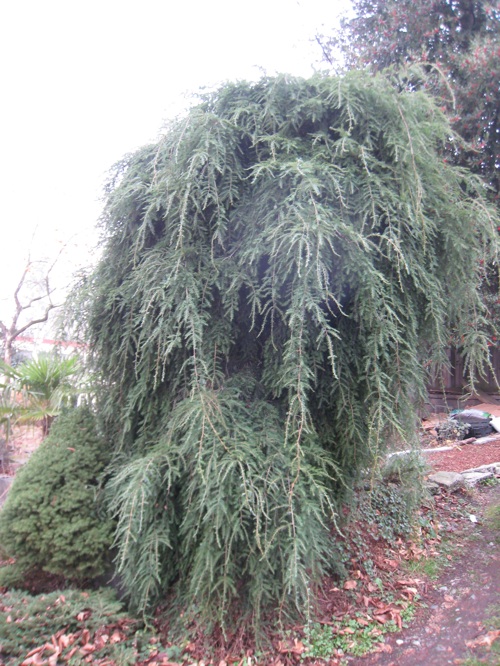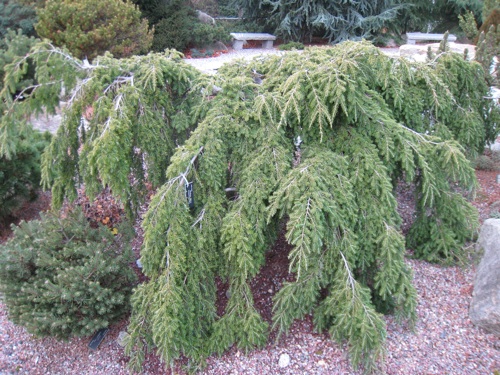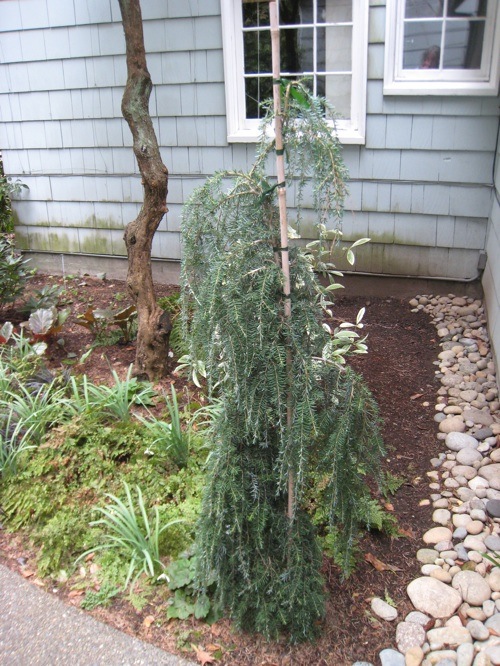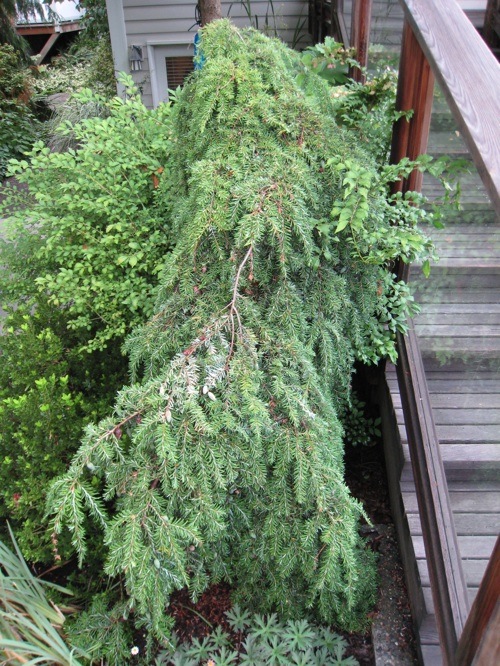| Several coniferous evergreen trees of relaxed, elegant habit are called hemlocks. The generic name Tsuga is Japanese and means the mother tree. In contrast, the original usage of the name "hemlock" applied to various poison hemlocks --malodorous weedy herbs (Cicuta and Conium species) in the parsley family (UMBELLIFERÆ or APIACEÆ). Hemlock trees are harmless if eaten. |
| The name "hemlock tree" was used as early as 1672 in a book by Englishman John Josselyn --New England's Rarities Discovered, when he studied New England and its plants between 1663 and 1671. Josselyn wrote (p. 54): "Hemlock Tree, a kind of Spruce, the bark of this Tree serves to dye Tawny; the Fishers Tan their Sails and Nets with it. The Indians break and heal their Swellings and Sores with it, boyling the inner Bark of young Hemlock very well, then knocking of it betwixt two stones to a Plaster, and annointing or soaking it in Soyls Oyl, they apply it to the Sore: It will break a Sore Swelling speedily." |
| Hemlock trees tend to be comparatively delicate, shade tolerant, and prefer cool woodland conditions --or in any case loathe dry, hot summers. For landscape designs where the formal symmetric look of firs (Abies) and spruces (Picea) is too stiff, hemlocks can lend a graceful touch. Their needles are short, blunt and usually not stiff; their cones mostly thimble-sized or less; the leading tip of the trees droops distinctively. The genus as a whole has few cultivars, yet for some reason Tsuga canadensis sports variants lavishly, many of them dwarfish. The 1984 book Cultivated Hemlocks by John C. Swartley details the history and attributes of the cultivars. |
| Tsuga canadensis is called Eastern hemlock, Common hemlock, Canadian hemlock, or Hemlock spruce. It is from eastern North America and is Pennsylvania's State Tree. It has played a major role in horticulture. Its needles and cones are the smallest in the genus, the needles mostly a third of an inch to half an inch long, the cones one-half to three-quarters of an inch long. |
In recent years, an introduced bug from Asia, the Hemlock Woolly Adelgid (Adeleges tsugæ), that lacks natural enemies in North America, has spread throughout the eastern United States causing damage and death to thousands of hemlock trees. For more on this sad development, (click here)
|
| Tsuga canadensis f. pendula Beissn. |
| = T. canadensis 'Sargentii' (in part) |
Weeping hemlock
|
| As I use it presently, forma pendula is a collective name that embraces all weeping hemlock cultivars or seedlings. Some botanists prefer to limit the usage of the name clonally to what it was intended to designate in 1877, the year it was officially published. Parsons nursery of Flushing, New York, had a clone for sale by 1873; specimens were in cultivation even earlier: by the 1860s. |
Weeping hemlock cultivars include: 'Ashfield Weeper', 'Brookline', 'Cappy's Choice', 'Elm City', 'Jan Verkade', 'Kelsey's Weeping', 'Valentine' and 'Wodenethe'. Several of these comprise the much beloved Sargent weeping hemlocks, named after Henry Winthrop Sargent (1810 - 1882), of Fishkill-on-the-Hudson (now Beacon), New York. Winthrop was an indefatigable enthusiast for testing the success of conifers in the cold climate he lived in.
|
| Variously, weeping hemlocks are groundcovers, broad shrubs, or, after many decades, small trees, at most over 29 feet tall and 40 feet wide. Gardeners also may stake prostrate hemlock cultivars (such as 'Cole's Prostrate') to make small trees. |
| There is a 1983 book about weeping hemlocks: Giant Among the Dwarfs: The Mystery of Sargent's Weeping Hemlock, by Peter Del Tredici. |
Below are 5 photographs of large weeping weeping hemlock trees I am aware of in Seattle. I have no idea what their clonal or cultivar names are. Also shown are 2 photos of young specimens of Tsuga heterophylla 'Thorsen's Weeping' --a cultivar named in 1985. If any readers know of other exceptional Seattle weeping hemlock specimens, I will appreciate being informed about them. They are low-maintenance landscape shrubs that offer year-round beauty in their gentle profusion of healthy dark green.
Back |

Weeping hemlock over 8 feet tall at 309 22nd Avenue E; February 2003 photo by ALJ
|

Weeping hemlock over 10 feet tall on E Denny Way, west of 14th Avenue E; December 2009 photo by ALJ
|

Weeping hemlock about 6 feet tall and 13 feet wide at Kubota Garden Park; March 2010 photo by ALJ
|

very wide Weeping hemlock at Columbia School 3528 S Orca Street; March 2010 photo by ALJ
|

Weeping hemlock at SSCC Coenosium Rock Garden; December 2009 photo by ALJ
|

young, staked, 'Thorsen's Weeping' hemlock at the Dunn Garden; March 2009 photo by ALJ
|

'Thorsen's Weeping' hemlock in a back yard private Seattle garden; August 2008 photo by ALJ
|

